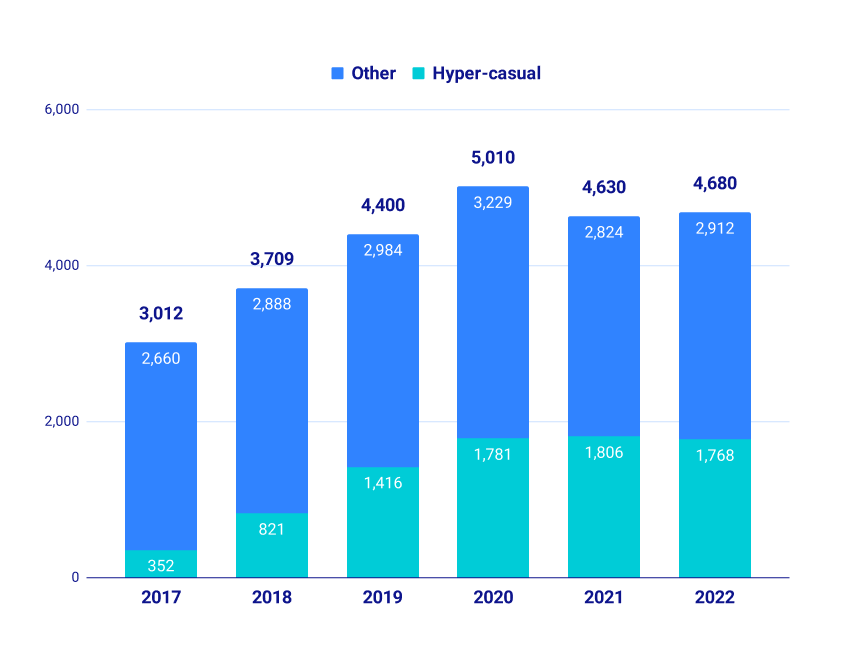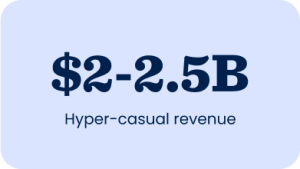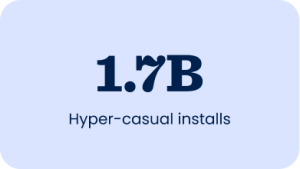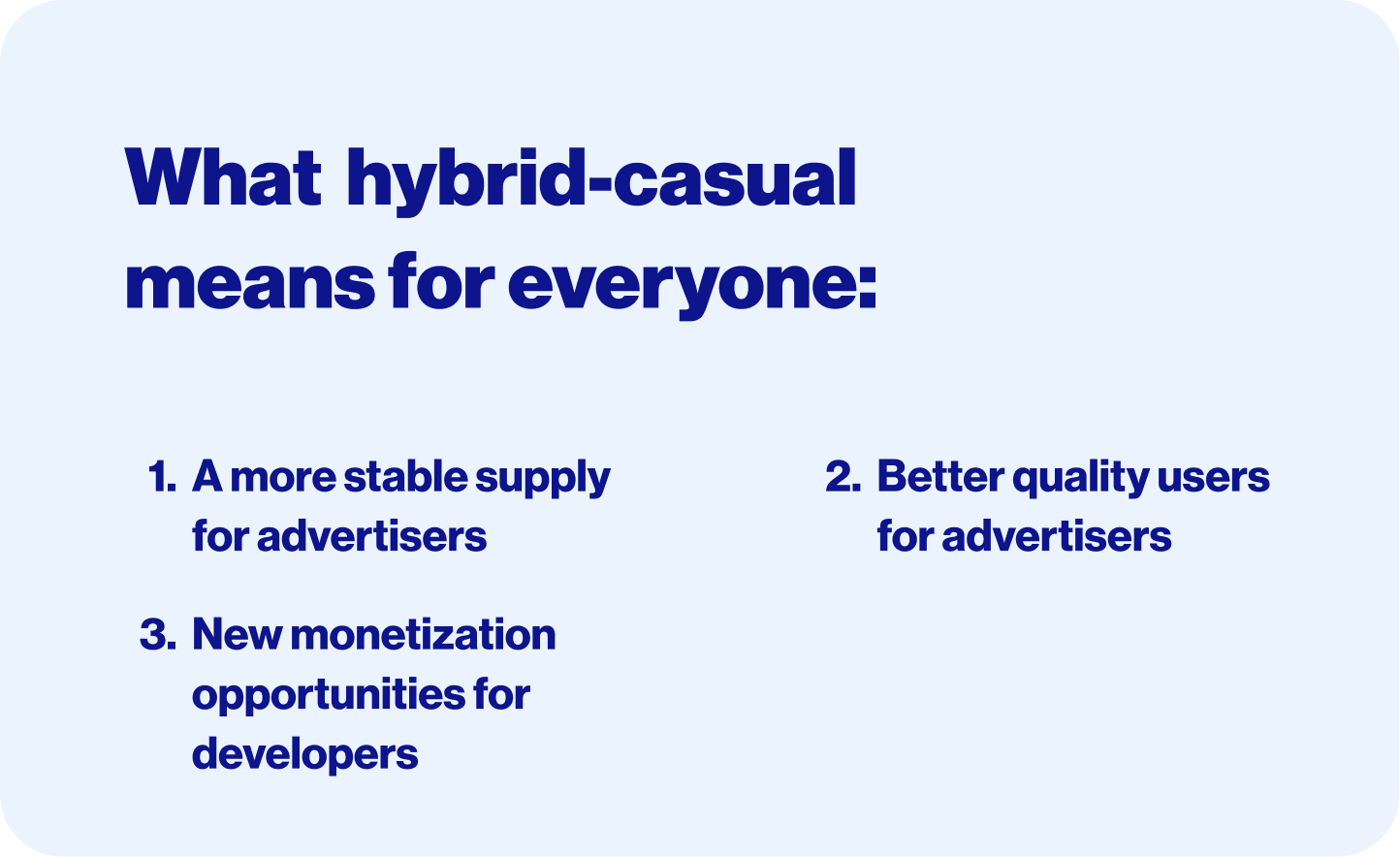The last 4 years are widely regarded as the age of hyper-casual. In just a few short years, the genre went from being relatively unheard of to taking 40% of the total share of voice for games - its snackability, accessible gameplay, and innovative creative strategy fueling its success.
This success also impacted other game genres, which looked to the mass appeal of hyper-casual games as a source of users and an opportunity for growth. Since 2017, mobile game installs saw a 20% YoY increase, driven by hyper-casual games boosting game installs overall. The resulting growth peaked in 2020, reaching over 5B installs in the US.
Since then, the growth of hyper-casual games has stayed consistent. But other mobile game genres haven’t been so lucky, with a moderate decline in downloads and eCPMs over the past two years thanks to macroeconomic shifts.

A changing market
Today, hyper-casual games still reach 1.7B installs per year and bring in $2-2.5B in annual revenue. But a decline in installs is starting to show. As downloads for other genres declined, demand from these genres declined too, leading to a current decline in hyper-casual growth.


It’s also no longer as easy as it once was to monetize hyper-casual games - eCPMs and LTVs have started to decline due to new regulations, app store policies, and macroeconomic conditions.
While the hyper-casual genre is still very much alive and kicking, these conditions have led to an organic pivot for some studios and publishers with a new genre of games emerging: hybrid-casual.
What are hybrid-casual games
Hybrid-casual games take the mass appeal and accessible mechanics of hyper-casual games and combine them with deeper gameplay loops and balanced economies of casual games. Hybrid-casual gameplay is still simple, but the quantity and quality of content are optimized for longer playtimes, aiming to keep players playing up to D60 and beyond. The result is a genre that remains accessible and marketable to the majority of players while having deeper content to motivate players towards rewarded ad units, IAP, and longer playtimes to create greater LTV.
Consequently, there is less of an emphasis on interstitial and banner ads compared to hyper-casual games. In general, hybrid games get 45% more rewarded video impressions and generate 20-50% of their revenue from IAP - significantly more than hyper-casual.
Also important is the longer development time required to create hybrid-casual games, usually 9-12 months. But this is not necessarily a bad thing. With games taking longer to develop, the market is less prone to saturation and is more stable - as of now, there are only roughly 15 successful hybrid-casual games that have reached scale.
What this means for everyone

1. A more stable supply for advertisers
Due to the small number of hybrid-casual games on the market, and the long development time needed to create new ones, advertisers can expect more stability from the hybrid-casual supply. In the past, hyper-casual games launched at a massive rate, so it was hard to predict which game your ads were running on and who was seeing them. But with a narrower supply of hybrid-casual games, advertisers are more likely to know where their ads are running and who is seeing them - allowing them to more reliably predict ROAS.
2. Better quality users for advertisers
This shift to hybrid-casual presents major opportunities for advertisers to acquire high-quality users. This is because hybrid-casual players are usually of higher quality and are willing to play and pay more than the average hyper-casual player. After all, they’re looking for a deeper game experience. The stability of the hybrid-casual market plus these higher quality players means that advertisers can acquire the right users.
3. New monetization opportunities for developers
Hyper-casual games primarily monetize with interstitial and banner ads, which enable explosive growth, but can feel invasive to some players and, with the current market conditions, might offer lower performance to advertisers.
In contrast, hybrid-casual games have a bigger focus on rewarded videos, and as a consequence playables. Rewarded videos are premium placements for playables since they motivate users to stay and watch an ad, rewarding them for doing it. Playable ad units demand a longer time commitment from the player (interstitial ads are usually limited to roughly 15 seconds, and playable ad units are often 45 seconds or more), but their conversion and engagement rates are far higher than interstitial ads.
Thanks to the longer playtime and deeper meta of hybrid-casual games, players are more motivated to engage with these ad formats, giving developers access to effective monetization opportunities.
A new mobile game market with hybrid-casual
The impact of the growing adoption of hybrid-casual will mean a bigger emphasis on playables and rewarded videos for developers. This will mean a better supply for advertisers who stand a stronger chance of converting users with these ad formats. Plus, the greater data predictability from the longer shelf-life of hybrid-casual games will lead to better optimization for developers and advertisers - offering great new avenues to success for both.


